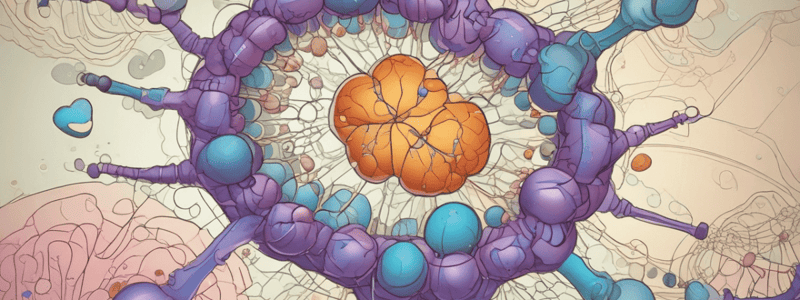Podcast
Questions and Answers
What is the primary function of cofactors in enzyme activity?
What is the primary function of cofactors in enzyme activity?
- To increase the substrate's binding affinity
- To inhibit enzymatic reactions
- To provide additional active sites for substrate binding
- To assist enzymes in catalyzing chemical reactions (correct)
What happens to enzymatic reactions when the temperature increases by 108C?
What happens to enzymatic reactions when the temperature increases by 108C?
- The reaction speed remains the same
- The reaction speed approximately doubles (correct)
- The reaction slows down
- The reaction comes to a complete halt
What is the term for the non-protein components that assist enzymes?
What is the term for the non-protein components that assist enzymes?
- Coenzyme
- Cofactor
- Trace element
- All of the above (correct)
Why do bacteria tend to grow more rapidly at higher temperatures?
Why do bacteria tend to grow more rapidly at higher temperatures?
What is the optimal condition range for enzyme function?
What is the optimal condition range for enzyme function?
What is the function of FAD as a coenzyme?
What is the function of FAD as a coenzyme?
What type of bonds are involved in the interaction between an enzyme and its substrate?
What type of bonds are involved in the interaction between an enzyme and its substrate?
What is the role of a cofactor in an enzyme-catalyzed reaction?
What is the role of a cofactor in an enzyme-catalyzed reaction?
What is the result of an enzyme-catalyzed reaction that joins two substrates to create one product?
What is the result of an enzyme-catalyzed reaction that joins two substrates to create one product?
What is a common function of coenzymes?
What is a common function of coenzymes?
What is the orientation of the substrate in the active site of an enzyme?
What is the orientation of the substrate in the active site of an enzyme?
What is the effect of an enzyme on the activation energy of a reaction?
What is the effect of an enzyme on the activation energy of a reaction?
What is the fate of the enzyme after an enzyme-catalyzed reaction?
What is the fate of the enzyme after an enzyme-catalyzed reaction?
What type of elements often function as cofactors?
What type of elements often function as cofactors?
What is the main reason why different enzymes require only a small number of coenzymes?
What is the main reason why different enzymes require only a small number of coenzymes?
Which group of vitamins is particularly important for the synthesis of coenzymes?
Which group of vitamins is particularly important for the synthesis of coenzymes?
What happens to an animal's enzymes if it lacks a particular vitamin?
What happens to an animal's enzymes if it lacks a particular vitamin?
What is the main difference between prokaryotes and humans in terms of vitamin synthesis?
What is the main difference between prokaryotes and humans in terms of vitamin synthesis?
What can happen to vitamins synthesized by bacteria in the intestine?
What can happen to vitamins synthesized by bacteria in the intestine?
What is the relationship between enzymes and coenzymes?
What is the relationship between enzymes and coenzymes?
What is the consequence of a single vitamin deficiency?
What is the consequence of a single vitamin deficiency?
Why are coenzymes necessary for enzyme activity?
Why are coenzymes necessary for enzyme activity?
Flashcards are hidden until you start studying
Study Notes
Enzyme Activity
- Environmental factors such as temperature, pH, and salt concentration influence enzyme activity, and each enzyme has a narrow range of optimal conditions.
- A 10°C rise in temperature approximately doubles the speed of enzymatic reactions.
Cofactors
- Cofactors are non-protein components, including coenzymes and trace elements, that assist enzymes in their function.
- Coenzymes are organic cofactors that function as loosely bound carriers of molecules or electrons in enzyme-catalyzed oxidation-reduction reactions.
- Examples of coenzymes include FAD, NAD+, and NADP+, which carry electrons in enzyme-catalyzed oxidation-reduction reactions.
Enzyme-Substrate Interaction
- The interaction of an enzyme with its substrate is highly specific, requiring a spatial fit and appropriate chemical interactions such as hydrogen and ionic bonding.
- The substrate fits into the active site of the enzyme like a hand into a glove.
Coenzyme Function
- Coenzymes can be used repeatedly and transfer substances from one compound to another.
- Different coenzymes function in different ways, but all transfer substances or electrons in enzyme-catalyzed reactions.
- Coenzymes are often derived from vitamins, particularly B vitamins.
Vitamin Importance
- Humans and other animals cannot synthesize most vitamins, so they must be ingested as part of the diet.
- A vitamin deficiency can impair the function of multiple enzymes that require the corresponding coenzyme, leading to serious consequences.
Studying That Suits You
Use AI to generate personalized quizzes and flashcards to suit your learning preferences.




